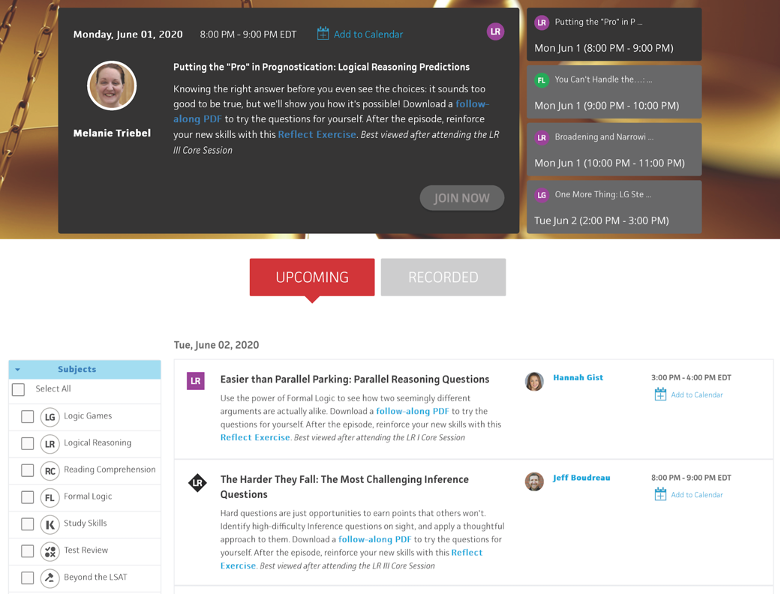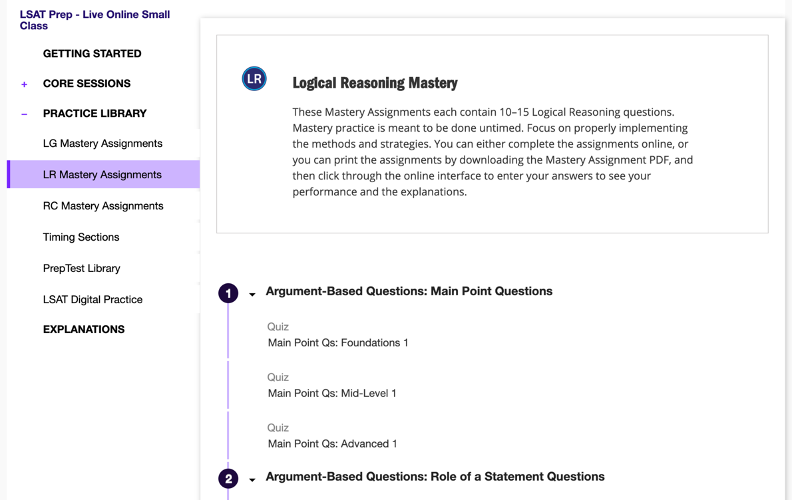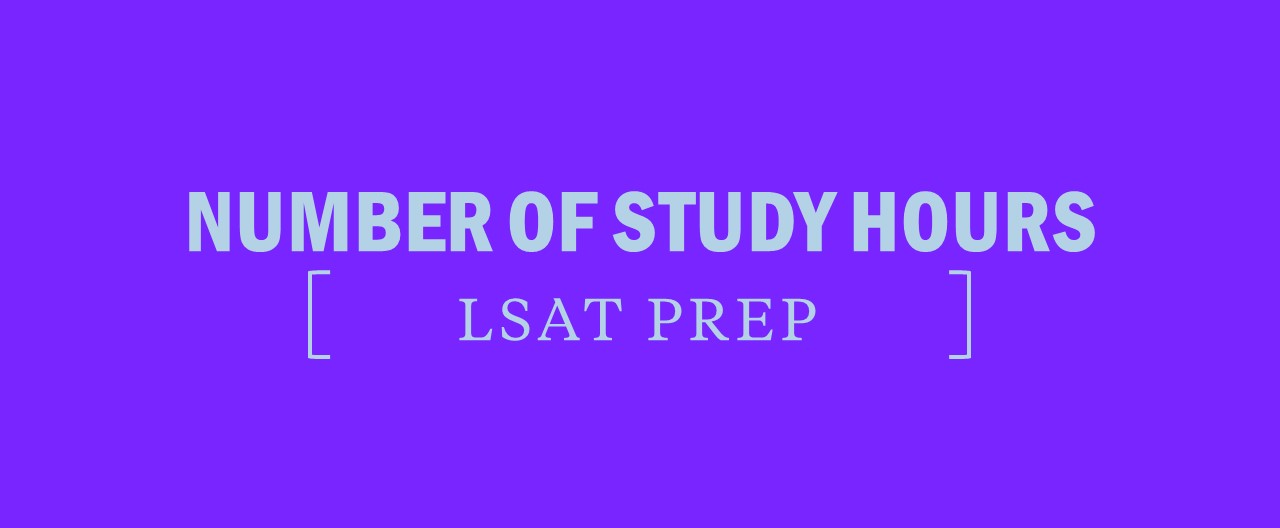LSAT 1-Month Study Guide
Although one month is a relatively short amount of time to spend studying for the LSAT, we’ve laid out a study plan, materials, and tips that will help you succeed on the LSAT. This post references Kaplan’s LSAT book, but the study plan will be equally helpful if you use a different book.
Best LSAT Study and Practice Materials
Here’s what you’ll need to get started with the LSAT model study plan that follows.
- Kaplan LSAT Premium Prep: This is our flagship book for LSAT self-preppers. It provides the most effective method for each test section, lays out the strategies and tactics top scorers use on each question type, and contains hundreds of drills and official, released LSAT questions for practice and review. NOTE: This book is included, along with a separate lesson book, in all Kaplan’s comprehensive LSAT prep courses, so if you’re enrolling in one, don’t buy it twice.
- If you have an LSAT book other than Kaplan’s LSAT Premium Prep, you can still benefit from following the model study plan below. Simply find coinciding readings and activities in the book you have with the ones listed in the model study plan.
- Official LSAT PrepTests: The Law School Admissions Council [LSAC], the organization that creates and administers the LSAT, releases three official tests every year. These are available for purchases as PrepTests (the commercial name LSAC uses) and they are a must for serious LSAT preparation. While you can buy PrepTests as individual numbered booklets, you will want several (and maybe even several dozen). There are three ways to acquire multiple PrepTests:
- LSAC Prep Plus [digital]: LSAC offers unlimited practice with 70 PrepTests in the digital interface you will use on test day through their Official LSAT Prep Plus You will want to do at least some of your practice in the digital interface, but if you already have printed versions of the PrepTests, LSAC offers free access to two PrepTests. Follow the link above and register for Official LSAT Prep (no Plus) for the free version.
- 10 Actual, Official LSATs [print]: Over the years, LSAC has collected released PrepTests into sets of 10. It’s less expensive and more convenient than buying 10 individual test booklets, but the tests in these printed bundles largely overlap with the digital tests in the Official LSAT Prep Plus bundle, so don’t get both.
- Kaplan LSAT Prep Course [comprehensive—recommended]: This is the best of both worlds. Every Kaplan comprehensive LSAT prep course—all of our live online, on-demand, and private tutoring options—include PDFs of every released PrepTest and we are discounting all of our courses by the price of LSAC’s Official LSAT Prep Plus so that all of our students have full digital study options, too. AND, there’s an even bigger reason to do all of your practice through a Kaplan LSAT prep course: complete explanations and analysis of every released question. While LSAC PrepTests (digital and print) provide answer keys and score conversion tables, they don’t provide all of the tools you need for thorough self-assessment. When you use your PrepTests in a Kaplan course, your score is calculated automatically, your results are analyzed by section and question type, and you have access to expert explanations for every question at the click of a button. Only comprehensive analysis and feedback allows for true personalization of your LSAT prep.
- Kaplan LSAT Flashcards: While not required for the model study plans that follow, this deck of 400 drills, games, and questions provide excellent practice while you’re in transit, when away from your computer, or when you just need a break from books and tests. Some flashcards inappropriately treat the LSAT as a memorization test, but Kaplan’s LSAT Flashcards provide analytical exercises that help you prepare for real test day reasoning, inference, and deduction.
- If you do not have access to Kaplan’s LSAT Flashcards, use whatever flashcards you have.
Top LSAT Study Tips
- One key to success: Practice.
- Unlike most exams you’ve taken in school, the LSAT does not test your knowledge of particular subject matter. Rather, the LSAT is skills-based. You can’t cram or memorize your way to success. Practice takes time.
- Four skills to master: Reading Strategically, Analyzing Arguments, Understanding Formal Logic, and Making Deductions.
- This is how Kaplan characterizes the four overarching skills required for a top LSAT score. These skills cut across the sections of the test, and we’ve designed our books and courses to help students master them all.
- Three types of practice: Mastery, Timing, and Endurance.
- Top scorers know that building LSAT expertise requires…
- Patient, untimed practice on individual questions and logic games to understand how they work and to instill a methodical approach to each type, question and logic game on the test (mastery practice),
- 35-minute timed practice to build strategy and confidence in managing each section of the LSAT (timing practice), and
- Full-test timed practice to build up the stamina required to sustain high performance across the entire exam (endurance practice). You’ll see these different types of practice in the model study plans that follow (and in every Kaplan LSAT book and course).
- Top scorers know that building LSAT expertise requires…
- One more thing to remember: Review your work.
- Doing practice sections and taking practice tests is essential, but the greatest opportunity for score improvement comes from using your results to assess your individual strengths and weaknesses and then adjusting your approach to address them. Many well-intentioned test takers overlook this important opportunity to personalize their LSAT preparation. After the model study plans, we’ll give you some expert tips on how to accomplish this (and show you how and why Kaplan LSAT prep courses always use performance data to provide individualized practice recommendations).
Model LSAT 1-Month Study Plan
To make the most out of your study plan, consider the following as you work through the model:
- One month is the minimum for LSAT prep. You can make great score improvements with one intense month of study, practice, and review, but most expert LSAT faculty will recommend a longer schedule if one is possible for you. Once you’ve taken a full-length practice test under timed conditions, compare your score to your goal score. Then, factor in the amount of time you’ll have to study. Are you looking for an LSAT score improvement of, say, 10 or even 15 points? Are you working or going to school during your prep? Do you have other family obligations? If one or more of those factors concerns you, please check out Kaplan’s model 2- and 3-month study plans. For more insight, chat or call a Kaplan LSAT expert about your study plans.
- Adapt the model to meet your needs. No model study schedule will be exactly right for you. Apply the principles illustrated here to your own calendar, and then keep the times you’ve allocated to LSAT study and practice free from other obligations and interruptions. Throughout the model plan, you’ll find notes to help you make the most of the plan. After the model, there is an important section with additional tips on how to personalize your LSAT study and practice.
- Keep in mind that while the chapters listed in the study plan below are specific to the Kaplan LSAT Prep Plus 2020-2021 book, you can likely find coinciding chapters in whatever LSAT book you have. If you don’t have the Kaplan book, take some time before you begin studying to customize your study plan by identifying readings for each assignment and writing them down.
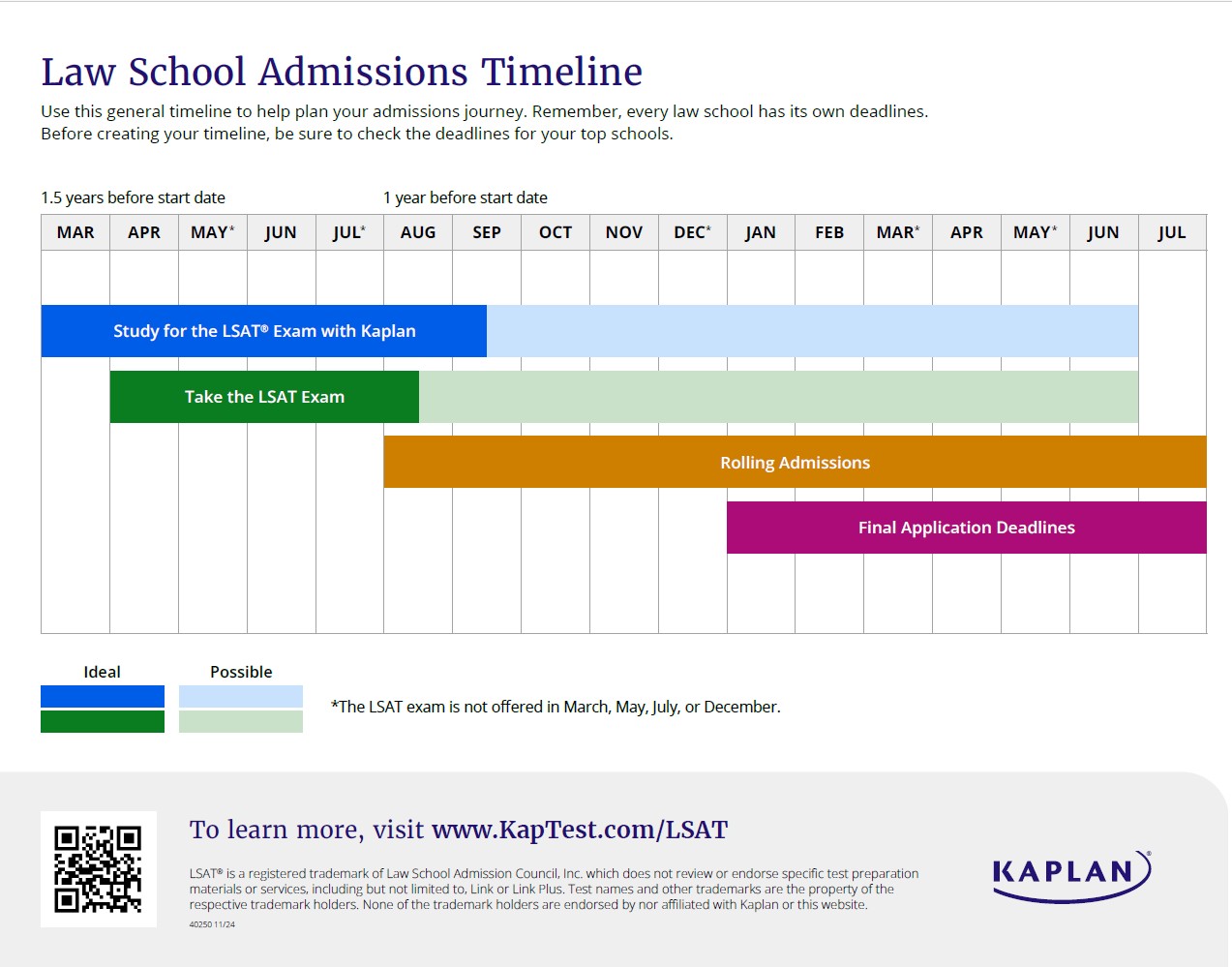
LSAT Study Schedule: Week 1
| Week 1 | Sunday | Monday | Tuesday | Wednesday | Thursday | Friday | Saturday |
|---|---|---|---|---|---|---|---|
| Morning | Family Time – no LSAT | Take a “diagnostic test.” Take a full-length official LSAC PrepTest to establish a baseline score.² | Kaplan’s LSAT Prep Plus – read and work through – Chapter 2: Logic Games Method – Chapter 3: Logic Games Overviews, Sketches, and Game Types | Kaplan’s LSAT Prep Plus – read and work through – Chapter 7: Logical Reasoning Method – Chapter 8: Argument-Based Questions | Kaplan’s LSAT Prep Plus – read and work through – Chapter 11: Reading Comprehension Method – Chapter 12: Passage Types and Question Types | Work/School – no LSAT | Day off – no LSAT⁷ |
| Afternoon | Get started: – Read Kaplan’s LSAT Prep Plus “Introduction: About the LSAT” – Create LSAC Prep Plus account for digital practice | Review the “diagnostic”: – Check your results by test section and question type. – Catalog what you got right and wrong.³ | Work/School – no LSAT⁴ | Logical Reasoning mastery practice – min. 10-20 Argument-Based Questions | Work/School – no LSAT | Mixed mastery practice – 1 or more logic games – 10+ Logical Reasoning questions – 1 or more Reading Comprehension passages⁶ | Day off – no LSAT |
| Evening | Register for your official test at www.lsac.org.¹ | Kaplan’s LSAT Prep Plus – read and work through Chapter 1: LSAT Reasoning | Logic Games mastery practice – min. 2-4 Strict Sequencing Games⁵ | LSAT Flashcards review or additional mastery practice as time permits | Reading Comprehension mastery practice – min. 2-4 passages and question sets | Personal – no LSAT | Day off – no LSAT |
Notes:
- Register for your official test as soon as possible. The rest of your study plan is designed to lead up to your official test day.
- Use a recent PrepTest. Kaplan LSAT prep courses always have a Diagnostic test and other assessments at the beginning of the course experience to help students self-assess.
- See the “Personalize Your LSAT Preparation” section following the model study plan for more details about why and how to do this.
- This model study plan leaves a few blocks per week LSAT free to reflect the reality of students’ lives. Adapt your personal work, school, and family schedule as necessary.
- Targeted mastery practice is one of the more difficult things for self-preppers to do well. In comprehensive Kaplan LSAT prep courses we’ve set aside more than 3,000 officially released questions for Mastery Practice assignments arranged by question type and difficulty so that our students can practice exactly what they need when they need it (and avoid the time and hassle of tracking down the right questions among all the PrepTests). For more helpful hints, see the “Personalize Your Last Preparation” section following the model study plan. Note: This particular assignment is illustrative of the importance of Mastery Practice in general. Strict Sequencing games are by far the most common game type, and you’ll want to spend more time practicing them than any other game type. A good mastery practice session should include between 10-20 questions followed by thorough review.
- It’s okay to try game types and question types you haven’t studied yet, but remember that you’ve got more learning to come. Always note the question types you miss to identify patterns associated with your strengths and with your areas of opportunity for improvement.
- Keeping one full day per week LSAT free is recommended. Use it for exercise, errands, and anything you feel you “should be doing” during your study and practice time. It may not be on Saturday for you but find some time for the study-life balance.
LSAT Study Schedule: Week 2
| Week 2 | Sunday | Monday | Tuesday | Wednesday | Thursday | Friday | Saturday |
|---|---|---|---|---|---|---|---|
| Morning | Family Time – no LSAT | Endurance practice – Take a full-length PrepTest (approx. 2½ hours)⁸ | Kaplan’s LSAT Prep Plus – read and work through – Chapter 9: Assumption Family Questions (pp. 545-642) | Kaplan’s LSAT Prep Plus – read and work through – Chapter 13: Reading Comprehension Perform Quiz | Kaplan’s LSAT Prep Plus – read and work through – Chapter 6: Logic Games Perform Quiz | Work/School – no LSAT | Day off – no LSAT |
| Afternoon | Kaplan’s LSAT Prep Plus – read and work through – Chapter 4: Logic Games Rules and Deductions – Chapter 5: Logic Games Questions | Review your full-length test: – Check your results by test section and question type. – Catalog what you got right and wrong. | Work/School – no LSAT | Kaplan’s LSAT Prep Plus – – review passages from Chapter 13 – read and watch Spotlight: Reading Comprehension – Managing the Section | Work/School – no LSAT | Timing practice – take and review 1 35-min Reading Comprehension section from a PrepTest – (if your schedule permits) take and review 1 35-min Logic Games section⁹ | Day off – no LSAT |
| Evening | Logic Games mastery practice – min. 1-2 Strict Sequencing games – min. 1 Loose Sequencing game – min. 1 ea. Matching and Distribution games | LSAT Flashcards review or additional mastery practice as time permits | Kaplan’s LSAT Prep Plus – read and work through – Chapter 9: Assumption Family Questions (pp. 643-712) | Mixed mastery practice – min. 2 logic games – min. 10 Logical Reasoning Assumption Family questions | Kaplan’s LSAT Prep Plus – review logic games from Chapter 6 – read and watch Spotlight: Logic Games – Managing the Section | Personal – no LSAT | Day off – no LSAT |
Notes:
- Find the right time(s) in your week for full-length testing. You’ll want to take full PrepTests under “test-like” conditions when you have an uninterrupted block of time during which you can turn off your phone and disconnect from all social media, email, etc.
- Set aside two or three PrepTests to use for Timing practice. Your goal here is to implement the section management strategies and tactics you learn from the LSAT experts in the section management spotlights. Complete Timing practice under “test-like” conditions: do the entire section uninterrupted, time yourself strictly, turn off your phone, and disconnect from other media. When you review, in addition to cataloging your right and wrong answers, consider where you could have been more efficient or made better time-management decisions.
LSAT Study Schedule: Week 3
| Week 3 | Sunday | Monday | Tuesday | Wednesday | Thursday | Friday | Saturday |
|---|---|---|---|---|---|---|---|
| Morning | Family Time – no LSAT | Endurance practice – Take a full-length PrepTest (approx. 2½ hours) | Logic Games mastery practice | Logical Reasoning mastery practice¹⁰ | Reading Comprehension mastery practice | Work/School – no LSAT | Day off – no LSAT |
| Afternoon | Kaplan’s LSAT Prep Plus – read and work through – Chapter 10: Non-Argument Questions | Review your full-length test: – Check your results by test section and question type. – Catalog what you got right and wrong. | Work/School – no LSAT | Kaplan’s LSAT Prep Plus – Review chapters and sections for question types you’ve identified as needing additional attention. | Work/School – no LSAT | Mastery Practice – min. 10-15 Qs in area of greatest opportunity Timing practice – min. 1 35-min section (your choice) + review | Day off – no LSAT |
| Evening | Kaplan’s LSAT Prep Plus – review questions from the end of Chapter 10 – read and watch Spotlight: Logical Reasoning – Managing the Section | LSAT Flashcards review or additional mastery practice as time permits | Timing practice – min. 1 35-min Logical Reasoning section + review | Timing practice – min. 1 35-min Reading Comprehension section + review | Timing practice – min. 1 35-min Logic Games section + review | Personal – no LSAT | Day off – no LSAT |
Notes:
- As you integrate more Timing practice into your study schedule, you can follow up with Mastery practice on the question types you most need to review.
LSAT Study Schedule: Week 4
| Week 4 | Sunday | Monday | Tuesday | Wednesday | Thursday | Friday | Saturday |
|---|---|---|---|---|---|---|---|
| Morning | Family Time – no LSAT | Endurance practice – Take a full-length PrepTest (approx. 2½ hours) | Kaplan’s LSAT Prep Plus – review chapters and sections for question types you’ve identified as needing additional attention | Timing practice – min. 1 35-min Reading Comprehension section + review | Timing practice – min. 1 35-min section (your choice) + review | Rest up for tomorrow! – Light review only – No reading or testing | Test Day: Go and crush your LSAT! |
| Afternoon | Kaplan’s LSAT Prep Plus – read and work through – Chapter 14: LSAT Writing | Review your full-length test: – Check your results by test section and question type. – Catalog what you got right and wrong. | Work/School – no LSAT | Mixed Mastery Practice – min. 10 questions from Q-types or game types in which you need additional practice | Work/School – no LSAT | Rest up for tomorrow! | Test Day |
| Evening | Kaplan’s LSAT Prep Plus – read and work through – Chapter 15: Countdown to Test Day | LSAT Flashcards review or additional mastery practice as time permits | Timing practice – min. 1 35-min Logical Reasoning section + review | Timing practice – min. 1 35-min Logic Games section + review | Method, Strategies, and Tactics review – Use your own notes and the LSAT Prep Plus book to go over your approach to each section of the LSAT. | Rest up for tomorrow! | Test Day |
Personalize Your LSAT Prep Study Schedule
While that model study plan illustrates expert advice about how best to balance study and practice across the sections of the LSAT, you can speed up your improvement by tailoring your practice to your individual strengths and weaknesses. Here are a few tips on how you can accomplish that in self-study along with some examples of how a Kaplan LSAT prep course can multiply the personalization effect.
Catalogue Your LSAT Results
Set up a spreadsheet (or just use a notebook) to record questions you got right and wrong, the question type, and some self-assessment about your performance. Here’s an example:
| PrepTest | Section | Q# | My Answer | Correct Answer | Question Type | Assessment |
|---|---|---|---|---|---|---|
| 75 | 1 | 13 | A | C | Inference | Misread stimulus |
| 75 | 1 | 14 | A | A | Role of a Statement | ✓ |
| 75 | 1 | 15 | E | C | Strengthen | Formal logic error |
Cataloging your performance will reveal your strengths and weaknesses among the various question types and game types on the LSAT, allowing you to tailor your Mastery practice to the areas in which you need the most work. If you don’t know what question type an item is, put “don’t know” under sixth column, and review the appropriate chapter in Kaplan’s LSAT Prep Plus (or whatever LSAT book you’re using) to identify it by the question stem or logic game setup.
In every Kaplan comprehensive LSAT prep course, we make this very easy for you. Whenever you score a released Prep Test (or even a single section of one) using a Kaplan “webgrid,” your results indicate each question type.

We’ve included more examples of how highly tailored LSAT prep can help you, based on samples from Kaplan’s LSAT prep courses, below.
Expert-Written Answer and Strategy Explanations
Clicking on the question type, links you directly to an expert-written explanation that goes over the best strategy for answering the question and why each wrong answer is wrong.
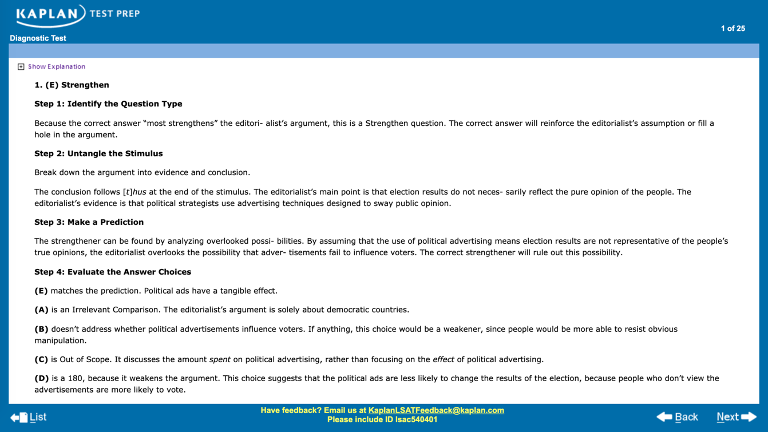
Results Broken Down by Section and Question Type
Kaplan students can see their cumulative results by section and even by question type.
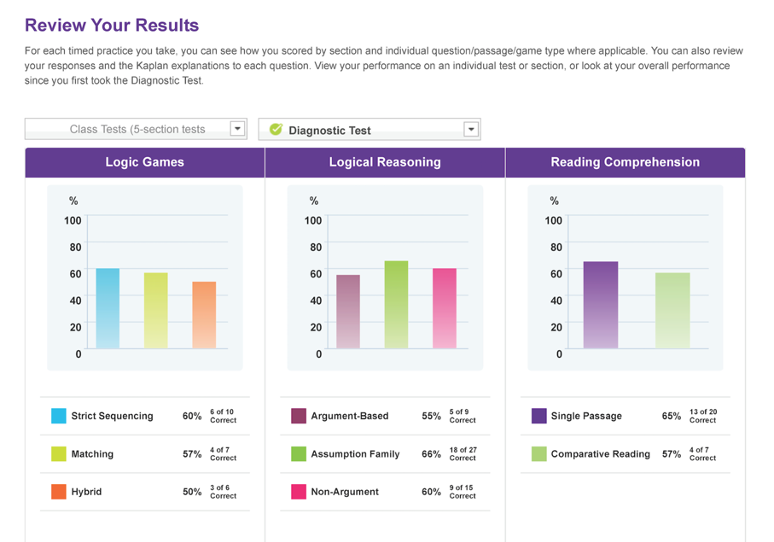
Individualized Study Recommendations
Finally, students in all Kaplan comprehensive courses receive individualized recommendations based on their test results. These guide students to a library of practice quizzes and additional live and recorded lessons on every question type and strategy you could ever see on the LSAT.
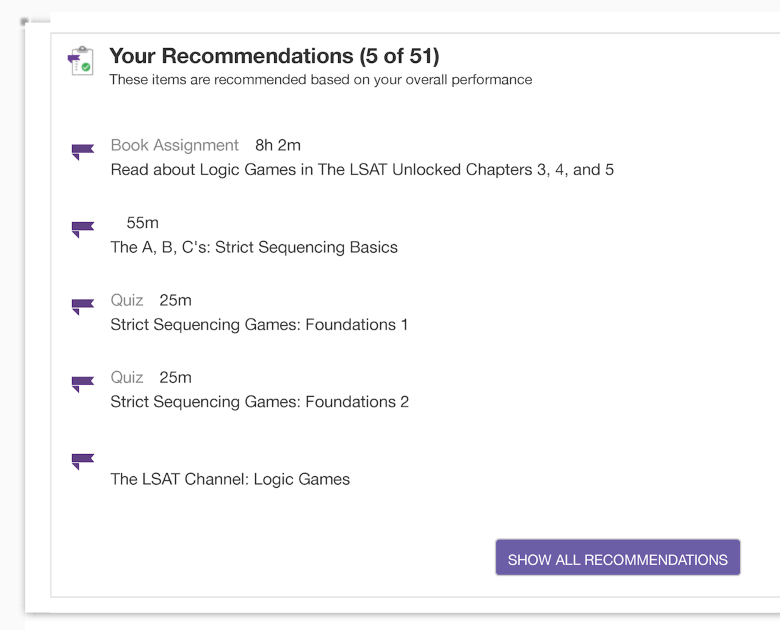
Practice is essential, but making sure your practice fits your precise needs is hard. At Kaplan, we do our best to help all of our comprehensive LSAT prep students have all the tools they need to maximize their score improvement.
Study every section of the LSAT every week.
Test takers prepping for the LSAT often overlook a simple but profoundly important maxim: Every LSAT question counts the same when it comes to your score. It’s understandable that students want to focus on the areas of the test that give them the most trouble, but the fact is that you may be able to add as many points to your overall score by polishing up your strongest areas as you can from improving in your weakest. Students who make the greatest score improvements do both.
Study at the appropriate LSAT difficulty.
The very best practice will be differentiated by difficulty level (just as the most effective lessons are): easier items for question types with which you’re struggling and more challenging for those in your wheelhouse. Unfortunately, there is no easy way to locate the easiest or hardest questions in the LSAT. Here are few rules of thumb that are true on the majority of test sections.
- Logical Reasoning: The highest concentration of easy questions in each section will be from questions 1-8 (although one or more may be of mid-level or even high difficulty). The highest concentration of hard questions is found between questions 14-22 in a given section (but not all of those questions will be high difficulty). There will likely be one or two mid-level or even easy questions near the end of the section (questions 23-26).
- Logic Games: The first two games in the section are likely to be easier than the last two games of the section (but at least two or three questions from the first two games may be among the hardest in the section as a whole). The third game is most often (but not always) the hardest game in the section. Learning the types of logic games is valuable because many students find that they have personal favorites (or the opposite).
- Reading Comprehension: This is the hardest section in which to distinguish easier and harder questions. That’s because each passage tends to have a questions that range from low to high difficulty. The hardest questions in the RC section tend to be Inference questions, especially those that are open-ended without specific line or paragraph references. To find material that is easier or harder for you individually, look for passages with subject matter that is more or less familiar (or, concomitantly, less or more intimidating).
Below are examples of how Kaplan’s LSAT prep course can help you identify personalized practice questions at different difficulty levels.
Whether or not you are using Kaplan resources to study for the LSAT, following a study plan like the one above can help you organize your study time effectively, gain confidence for LSAT test day, and achieve your LSAT score goals.


